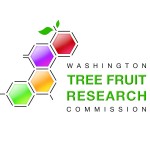Written by Tory Schmit, Tree Fruit Research Commission May 24, 2018.
When it comes to concerns over pesticide residues, cherry growers require a lot of complex, up-to-the-minute information to make appropriate management decisions. Specifically, they need to know exactly where their sales desks intend to export their crop, the most current Maximum Residue Levels (MRLs) allowed for every pesticide they apply in each of those foreign markets, AND have a reasonable idea of what residue levels are present for each of those pesticides on their fruit at harvest. Fortunately, there are resources available to help growers navigate this thorny regulatory thicket.
For several years, the Washington Tree Fruit Research Commission (WTFRC) has supported projects to develop information regarding residue levels produced by typical apple and cherry spray programs. Since 2011, they have applied more than 30 commonly used insecticides, miticides, and fungicides on commercial cherry orchards to determine harvest residue levels. Their studies have indicated that pesticide residues on cherries are not consistently reduced by the hydrocooling and packing process, suggesting that producers should not rely on such measures to ensure their fruit meets certain residue standards. WTFRC studies have also found that use of rain protectants like RainGard and Parka can sometimes preserve pesticide residues, especially for materials applied within a few weeks of harvest.
Even though residues for most fertilizers are not heavily regulated by the EPA, the EU’s definition of fosetyl-Al (Aliette) residues includes phosphite, a byproduct of potash fertilizers used early in the season by many Northwest cherry growers: as such, cherries treated with these products are likely to run afoul of fosetyl-Al MRLs in Europe, even if the grower never used Aliette. Detailed information on all WTFRC studies on apple and cherry pesticide residues are available at the homepage of their website http://www.treefruitresearch.com/, including a recently published document summarizing of all their cherry pesticide residue findings since the project began in 2012: https://treefruitresearch.com/images/2012-2017_Cherry_Residue_Summary.pdf
While most results through the years have been below key export MRLs, some products have produced residues that exceed tolerances in some export markets with conservative standards; based on WTFRC results and posted MRL values as of 21 May 2018, cherry growers hoping to export fruit to all foreign markets should be careful with use of:
- abamectin (Agri-Mek)
- acetamiprid (Assail)
- azoxystrobin (Abound)
- beta-cyfluthrin (Baythroid)
- carbaryl (Sevin)
- fenpropathrin (Danitol)
- flutriafol (TopGuard)
- hexythiazox (Onager)
- penthiopyrad (Fontelis)
- permethrin (Perm-Up)
- propiconazole (Orbit)
- potash/phosphite fertilizer
- thiophanate-methyl (Topsin)
- tolfenpyrad (Bexar)
- zeta-cypermethrin (Mustang)
The Northwest Horticultural Council (NHC) has done great work through the years to help with a wide range of regulatory issues in foreign and domestic markets. The NHC has been an important advocate for Northwest growers in helping resolve trade disputes and pushing successfully for the publication, standardization, and in many cases, relaxation of MRLs posted in foreign markets for numerous chemicals important to growing apples, pears, and cherries in our region. Further, they provide a great service to industry by publishing an updated list of important MRLs in key export markets http://nwhort.org/export-manual/comparisonmrls/cherry-mrls/. You can also find current MRL information for virtually any pesticide applied to any crop for any foreign market at the following website sponsored by Bryant Christie: http://bcglobalportal.com/
Finally, one of the surest ways for cherry growers to determine their precise pesticide residue levels is to have their own fruit tested by a reputable analytical lab. Pacific Agricultural Laboratory (PAL) (http://pacaglab.com/) is the leading service provider in the Northwest for analysis of pesticide residues on fruit crops. Cherry growers or warehouses can ship fruit samples to PAL’s lab outside of Portland and typically expect results back within 1-4 working days, hopefully in time to help determine where their fruit should or should not be shipped.
Growing, packing, and marketing cherries is stressful enough without the additional worry of complying with constantly changing MRLs – hopefully these resources can help growers along the way.
Contact
Project Manager
Washington State Tree Fruit Research Commission
Fruit Matters articles may only be republished with prior author permission © Washington State University. Republished articles with permission must include: “Originally published by Washington State Tree Fruit Extension Fruit Matters at treefruit.wsu.edu” along with author(s) name, and a link to the original article.


